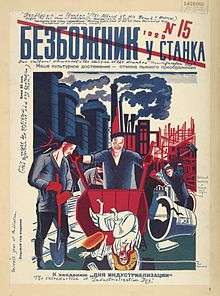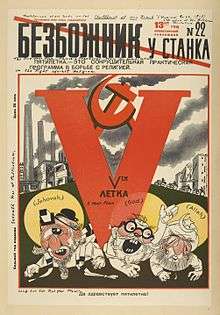Bezbozhnik (newspaper)
 22 April 1923 issue of Bezbozhnik | |
| Type | Daily newspaper |
|---|---|
| Format | Broadsheet |
| Founded | 1922 |
| Language | Russian |
| Ceased publication | 1935 |
|
Cover showing the gods (of Judaism, Christianity and Islam) being crushed by the First Five-Year Plan. | |
| Categories | Satirical magazine |
|---|---|
| Frequency | Monthly |
| Company | League of Militant Atheists |
| Country | Soviet Union |
| Language | Russian |
Bezbozhnik (Russian: Безбожник; "The Godless") was a anti-religious and atheistic newspaper published in the Soviet Union between 1922 and 1941[1] by the League of Militant Atheists. Its first issue was published in December 1922, with a print run of 15,000, but its circulation reached as much as 200,000 in 1932.[2]
Between 1923 and 1931, there was also a magazine called Bezbozhnik u Stanka (Безбожник у станка; "The Godless at the Workbench").[3]
History
Initially, the publication ridiculed all religious belief as being a sign of ignorance and superstition, while claiming that the religion was dying in the officially atheist Soviet Union, with reports of closing churches, unemployed priests and ignored religious holidays. Starting with the mid-1920s, the Soviet government saw religion as an economic threat to the peasantry, whom, it said, were being oppressed by the clergy.[4]
Its main targets were Christianity and Judaism, accusing rabbis and priests of collaborating with the bourgeoisie and other counter-revolutionaries (see White movement). The rabbis were accused of promoting hostility between Jews and Gentiles. Bezbozhnik alleged that some rabbis in the tsarist government's pay had helped organize anti-Jewish pogroms, while claiming that such actions had sparked similar atrocities in England, South Africa and other countries.[3]
Priests were attacked as being parasites who lived off the work of the peasants. It reported of priests who allegedly admitted deceiving peasants and who supposedly renounced their profession. For instance, it ran a story about a certain Sergei Tomilin, who allegedly claimed 150 kilograms of wheat and 21 metres of linen for each marriage he conducted, performing over 30 marriages in just a few weeks and thus receiving the wage a schoolteacher would have earned in 10 years.[4]
The magazine criticized the Jewish holiday of Passover as encouraging excessive drinking, because of the requirement of drinking four glasses of wine, while Prophet Elijah was accused of being an alcoholic who got "drunk as a swine".[3]
Writer Mikhail Bulgakov once visited the offices of the Bezbozhnik and got a set of back numbers. He was shocked by its content, not only by what he saw as "boundless blasphemy", but also by its claims, such as that Jesus Christ was a rogue and a scoundrel. Bulgakov believed that this was "a crime beyond measure".[5]
Bezbozhnik used humour as part of its anti-religious atheist propaganda, since humour was able to reach both educated and barely literate audiences. For example, in 1924, Bezbozhnik u Stanka issued a brochure called How to Build a Godless Corner, a tongue-in-cheek reference to the Eastern Orthodox Icon Corner. The brochure included a set of two big posters with anti-religious slogans, seven other smaller humoristic posters, six back issues from Bezbozhnik u Stanka, from which to cut other images and instructions on how to assemble it. Such corners were suggested to be made at workplaces and the owner was encouraged to spend time at them and to try to convert other workers.[6]
Decline and termination
In 1932, with the economy staggering from the economic dislocation associated with the First Five-Year Plan, the Cultural Revolution was halted and a more moderate and pragmatic approach towards religion and other aspects of Soviet life was initiated by the regime.[7] Destabilizing campaigns in the economy, education, and social relations were halted and a move made towards the restoration of traditional values.[8] Bezbozhnik began to stray away from its original subject, anti-religion and atheism and it began publishing more general political subjects.[4]
Membership in the League of the Militant Godless, which had ballooned during the Cultural Revolution to approximately 5 million plummeted to a few hundred thousand, bringing down the circulation of its newspaper in commensurate fashion.[8] The newspaper's circulation fell rapidly beginning in 1932 and was terminated completely in 1935.[8]
The League of the Militant Godless was closed down in 1941, during World War II and the invasion of the Soviet Union by Nazi Germany.[9]
Circulation
The newspaper Bezbozhnik launched on 21 December 1922.[10] During its first year of publication the paper's press run stood at 15,000 copies per issue.[11] The paper grew during the early years of the New Economic Policy, hitting the 100,000 mark in the summer of 1924 and topping 200,000 one year later.[11]
A decline followed from this early peak, with the press run of the publication tailing off to 114,000 in October 1925 and attenuating further to 90,000 in the fall of 1926.[11] This decline seems to have continued in subsequent months and the official press run was no longer publicized in the paper's pages from October 1926 through the first part of 1928, with a circulation of about 60,000 indicated by archival evidence.[11]
With the coming of the Cultural Revolution in 1929, Bezbozhnik was again the beneficiary of state promotion, with the circulation escalating to 400,000 in 1930.[11] With the move towards stabilization, the fall in circulation beginning in 1932 proved just as precipitous, with the publication being terminated in 1935.[8]
Examples of issues
-

"Anti-alcoholic" issue of Bezhbozhnik u stanka from 1929 portraying Jesus as a moonshiner
-

Bezhbozhnik u stanka issue from 1929 showing Jesus being dumped from a wheelbarrow by an industrial worker; the text suggests the Industrialization Day can be a replacement of the Christian Transfiguration Day.
See also
References
- ↑ Salvatore Attardo (18 March 2014). Encyclopedia of Humor Studies. SAGE Publications. p. 472. ISBN 978-1-4833-4617-5. Retrieved 22 November 2014.
- ↑ Milne (2004), p. 209
- 1 2 3 Anna Shternshis, Soviet and Kosher: Jewish Popular Culture in the Soviet Union,1923-1939. Bloomington, IN: Indiana University Press, 2006, p. 150-155.
- 1 2 3 Daniel Peris, Storming the Heavens: The Soviet League of the Militant Godless. Ithaca, NY: Cornell University Press, 1998; pp. 75-76.
- ↑ Lesley Milne, Bulgakov: The Novelist-playwright, Routledge, 1996; pg. 64.
- ↑ Milne (2004), p. 128
- ↑ Husband, "Godless Communists," pg. 159.
- 1 2 3 4 Husband, "Godless Communists," pg. 160.
- ↑ Steven Merritt Miner, Stalin's Holy War: Religion, Nationalism, and Alliance Politics, 1941-1945. Chapel Hill, NC: University of North Carolina Press, 2003; pg. 80.
- ↑ William B. Husband, "Godless Communists": Atheism and Society in Soviet Russia, 1917-1932. DeKalb, IL: Northern Illinois University Press, 2000; pg. 60.
- 1 2 3 4 5 Husband, "Godless Communists,'"' pg. 61.
Further reading
- William B. Husband, "Godless Communists": Atheism and Society in Soviet Russia, 1917-1932. DeKalb, IL: Northern Illinois University Press, 2000.
- Lesley Milne, Reflective Laughter: Aspects of Humour in Russian Culture, Anthem Press, 2004.
- Daniel Peris, Storming the Heavens: The Soviet League of the Militant Godless. Ithaca, NY: Cornell University Press, 1998.
